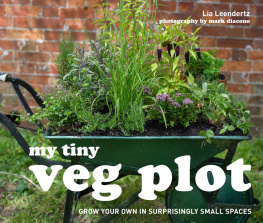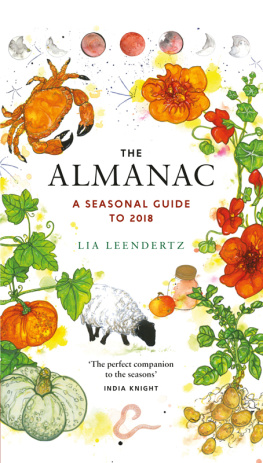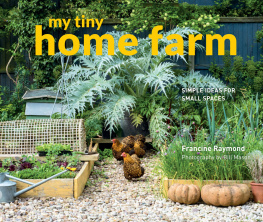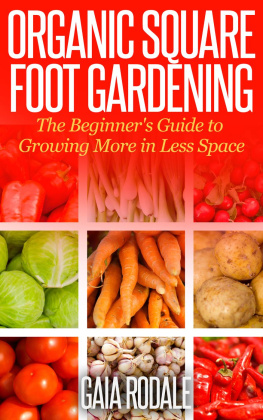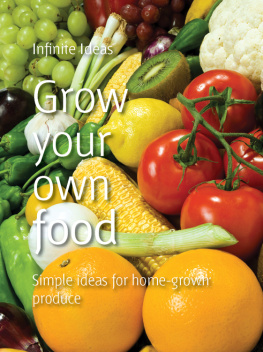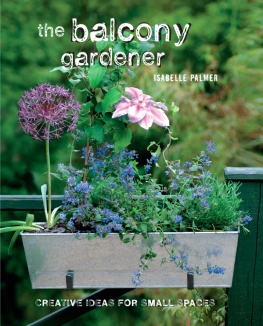my tiny veg plot

my tiny veg plot
Lia Leendertz
Photography by Mark Diacono

contents

The most delicious of edible crops can be fitted into the tiniest of spaces.
introduction
Think you dont have enough space to grow your own fruit and vegetables? Think again. This book concerns the tiniest of productive gardens: those that have been squeezed in the most unlikely fashion onto flights of steps, balconies, boats and roof terraces. There is even one in an old swimming pool. Most would have deemed these spaces too tiny to bother with, but they come with a set of determined and often ingenious gardeners that have transformed them into something special. These gardens prove that small is not only beautiful, but it can be surprisingly productive as well.
Gardeners often spend their lives yearning for more space in which to grow a greater volume of crops, but tiny gardens need not be the poor relation of the big patch, or just a stepping stone towards your acre. Small gardens have a huge amount going for them in themselves: they are easy to care for and to fit around a busy life, whereas large gardens and allotments can quickly become overwhelming and all encompassing; and they are near at hand, so that problems with pests and diseases are spotted early and dealt with quickly, and produce is picked when it is at its peak. You will never let a French bean grow past its sweet and compact best, or let a slug strip the whole plant to the ground, when it is positioned in the side return just outside your back door. It is also the case that many of the strongest-flavoured crops are small think herbs, chillies, garlic and so it is very easy to create a tiny garden that punches well above its weight in flavours.

Food crops can be beautiful as well as delicious.

A clever planter that doubles as a bicycle lock.

Herbs are among the best plants to grow if you have little space: compact and full of flavour.
And you are not limited to only growing herbs. A great range of vegetables will grow well in containers if given the right care, as will beautiful dwarf fruit trees and bushes, and all will love the extra attention they receive at the hands of a gardener who isnt overwhelmed by a huge garden and all of its attendant chores. In short you can grow a great range of the best quality, most delicious produce from a tiny plot, and all with minimum stress.
This is all possible if you choose crops carefully to suit your situation, and design your garden well with the limitations of your space in mind, and this book contains an array of tiny gardens from which to seek inspiration in setting about such a task. The first chapter is about high-rise growing: those gardens that are wedged into balconies or that teeter on rooftops. These gardens offer both challenging and hugely rewarding conditions: winds and weather can dry out plants and wreak havoc but these gardeners have high light levels and wonderful views to more than compensate their struggles, and all of them seem very happy with their lot. Chapter two concerns urban growing, and all of its gardens have been shoehorned around the architecture of the city: pots arrayed up steps, a roofed veranda for city privacy, and a planter that doubles as a bicycle rack. In chapter three we see the ways in which the smallest of gardens can be used for the greater good, to create community cohesion, to experiment with environmentally friendly ways of growing, and to concentrate fertility in lands with poor soils. Chapter four is about mobile gardens, those in the back of trucks and campervans, all of which exploit to the full the ability of plants to grow wherever they can get sustenance and light. Chapter five is about the tiniest of all gardens, and is for those people who believe they have nowhere they can grow: they are mistaken. There is always some way of growing food and this chapter will show you how. In chapter six we learn some lessons from businesses who grow tiny crops for their amazing strong flavours, and finally in chapter seven we look at some of the tiny gardens that have grown up in some of the most unlikely places: near to or floating on water, on boats and tiny banks. Together these chapters cover a vast array of gardens and gardeners all with one thing in common: they are working creatively with what little space they have, making amazing edible gardens on the small scale.
This is not just an inspirational book. In addition to the garden profiles, this book contains panels that will teach you the techniques you need to make use of every inch of your space, from planting up edible hanging baskets, to growing herbs in cracks in paving, to supporting and training your crops so that they grow upwards, and thus take up little space on the ground. These panels also discuss the slightly more serious business of watering and feeding plants in containers are entirely dependent on us for their moisture and sustenance, and unlike their counterparts in the open ground are unable to reach out into the soil for new sources of either during periods of drought, or when one area of soil is depleted of nutrients. Paying attention to watering and feeding is crucial in creating a tiny container garden that grows and crops well and looks thriving and beautiful, and you will find ideas on how to ensure you do this effectively in these practical panels.
But the message this book most wishes to pass on is: dont give up too easily. If you wish to grow your own crops but have convinced yourself that you dont have any space in which to do so, spend some time among these pages. They may make you look at your own space with fresh eyes. There is a certain magic to growing in unlikely places that those with the luxury of space may entirely miss out on. Maybe you can have a tiny salad garden, maybe you can even make a miniature orchard. I hope that you will enjoy looking at these brilliant little gardens, and that you will be inspired by seeing what other gardeners have achieved to create your own tiny veg patch.
Lia Leendertz

Even the most unusual crops, such as South American tuber oca, can be grown in pots.
raise em high

High-rise spots such as rooftops and balconies can make for the most pleasing miniature vegetable gardens: unexpected oases of greenery and colour. There are few things more uplifting than spotting a thriving garden up among the chimney tops, all unlikely. Greenery up so high carries the mark of a dedicated gardener without one little could grow for more than a few days so far from nourishing earth and we all love to see a well-loved space. Lifted out of the shade of neighbouring buildings and trees, these can be some of the lightest and brightest of city gardens, and increased light levels make them surprisingly productive, as plants feed greedily on the sunlight and then convert it into delicious crops.
Next page
